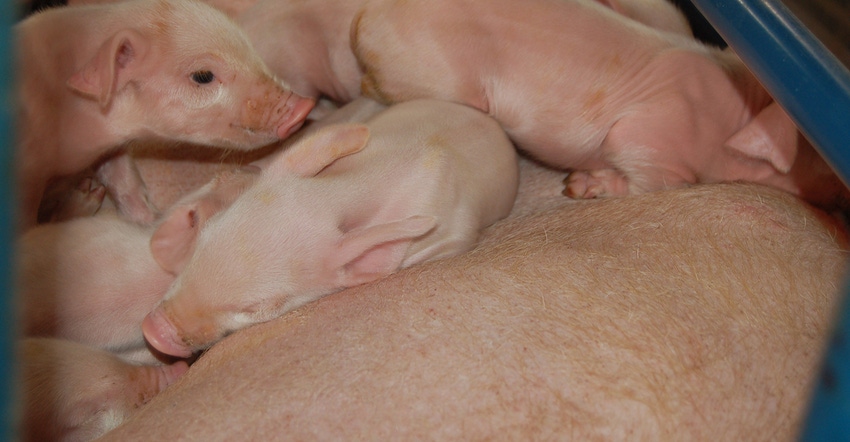
With six packer plants in the Midwest either expanding or opening by fall 2019, Minnesota swine producers will have interesting days ahead of them, according to Diane DeWitte, University of Minnesota Swine Extension educator.
Three of the plants will be less than 200 miles from Minnesota’s top pork production areas, including Blue Earth County.
DeWitte says that Prime Pork in Windom will be processing 6,000 pigs per day when it is running at capacity this fall. Triumph-Seaboard has a new plant in Sioux City, Iowa, which is expected to process 12,000 pigs per day by this fall. And by fall 2019, Prestage Farms, which is building a new packing facility in Eagle Grove, Iowa, will be processing 10,000 pigs per day.
Additionally, Moon Ridge Foods has started processing 3,000 pigs per day in Pleasant Hope, Mo., and Clemens Food Group will open its 10,000-head-per-day-capacity plant in Coldwater, Mich., this fall. The sixth plant is an expansion at Rantoul Foods in Rantoul, Ill.
Management review may raise profit
With the marketing pull for pork, reviewing sow management practices might improve producers’ bottom line.
“Recent swine studies focus on management practices which can feed the pregnant and lactating sow, who will be raising and weaning 13 or more pigs per litter,” De Witte says. “In addition, research attention is being paid to the birth and weaning weights of these large litters to learn whether the pigs are efficient feed converters, and if their carcasses deliver consistent-quality pork to the packer.”
Research investigating the effect of litter size on pigs' pre-weaning growth by Kansas State University found relatively few differences between larger and smaller litters in the variability of pig size at birth through weaning. North Carolina State University research has shown that low birth weights yield pigs that are less likely to develop a full-value carcass when compared to their littermates of average or larger birth weights. These results all point back to that all-time favorite production challenge — feeding the sow, DeWitte says.
Feeding for desired results
“But it's not just about feeding the lactating sow,” she adds. “Replacement gilts need to be carefully developed. In order to have females to provide enough pigs to fulfill packer demands, they must be grown and fed not just for productivity, but for longevity, too.”
Replacement gilts must be fed separately and differently from their counterparts in the finishing barn. Gilt development rations need to contain higher levels of calcium and phosphorus to provide a good foundation of bone development to take a sow through her first parity and beyond, she says. Both university and industry research indicate that it is most economically efficient and physiologically appropriate to breed gilts at 300 to 320 pounds, and after they've attained estrus a minimum of two times.
After the gilt is pregnant, feeding a nutrient-dense gestation ration enables her to deliver fewer low-birth-weight piglets. Studies relating to gilt body types also point to the differences between thicker-muscled, leaner gilts versus lighter-muscled gilts with an extra quarter-inch of backfat.
“Backfat has traditionally been the measure of a gilt's development,” DeWitte says. “By concentrating more on the gilt's body condition and keeping her size under control, producers can reduce feed costs in gestation and bring her to the farrowing room with a hearty appetite. Sows that eat aggressively in lactation are able to maintain their body condition and also wean a heavier litter.”
U-M swine nutritionists recommend feeding diets with higher nutrient concentration to young sows of parity 3 or less to help them minimize loss of body weight during lactation. Older sows can feed their litters and maintain their body condition when consuming diets which more closely fulfill their gestation and lactation requirements.
Creep feeding
Kansas State University research has found that pigs ages 21 days and older get the most benefit from creep feeding, DeWitte says.
“Even when they are introduced to it [creep feeding] at an older age, they may actually consume more creep feed overall than pigs who were started on creep feed at a younger age,” she says. KSU research also found that creep feeding may not realize heavier weaning weights than pigs that were not provided creep feed. Because the pigs were eating when they were weaned, however, they gained weight faster after weaning.
Today's genetics allow sows to produce large numbers of fast-growing pigs, DeWitte notes. “The sow, in turn, must be able to lactate profusely, maintain her body condition and return to the breeding herd ready to develop another large litter,” she says. “These [production goals] are all possible with meticulous management practices.”
About the Author(s)
You May Also Like






